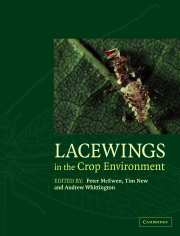Book contents
- Frontmatter
- Contents
- List of contributors
- Preface
- PART 1 Lacewing systematics and ecology
- CHAPTER 1 Introduction to the Neuroptera: what are they and how do they operate?
- CHAPTER 2 Introduction to the systematics and distribution of Coniopterygidae, Hemerobiidae, and Chrysopidae used in pest management
- CHAPTER 3 The common green lacewing (Chrysoperla carnea s. lat.) and the sibling species problem
- CHAPTER 4 Recognition of larval Neuroptera
- CHAPTER 5 Ecology and habitat relationships
- CHAPTER 6 Natural food and feeding habits of lacewings
- CHAPTER 7 Outlines of lacewing development
- PART 2 Lacewings in crops
- PART 3 Principles
- PART 4 Case studies
- PART 5 Conclusion
- Taxonomic index
- General index
CHAPTER 6 - Natural food and feeding habits of lacewings
Published online by Cambridge University Press: 04 May 2010
- Frontmatter
- Contents
- List of contributors
- Preface
- PART 1 Lacewing systematics and ecology
- CHAPTER 1 Introduction to the Neuroptera: what are they and how do they operate?
- CHAPTER 2 Introduction to the systematics and distribution of Coniopterygidae, Hemerobiidae, and Chrysopidae used in pest management
- CHAPTER 3 The common green lacewing (Chrysoperla carnea s. lat.) and the sibling species problem
- CHAPTER 4 Recognition of larval Neuroptera
- CHAPTER 5 Ecology and habitat relationships
- CHAPTER 6 Natural food and feeding habits of lacewings
- CHAPTER 7 Outlines of lacewing development
- PART 2 Lacewings in crops
- PART 3 Principles
- PART 4 Case studies
- PART 5 Conclusion
- Taxonomic index
- General index
Summary
INTRODUCTION
Feeding habits of lacewings are relatively well known in chrysopids but understudied in other groups. The review presented here concerns the ecological and behavioural aspects of feeding; the physiological aspects, the nutritional requirements as well as the artificial trophic relationships induced by mass-production and agricultural use of lacewings will be given elsewhere (see Chapter 11, this volume).
Feeding in Neuroptera larvae shows peculiarities derived from the structure of mouthparts and gut of which fine and complete descriptions are available (e.g. Killington, 1936; Rousset, 1966). Mandibles and maxillae are elongate, interlocked together to form strong jaws acting as sucking tubes. The jaws are longer than or approximately as long as the head and inwardly curved in green and brown lacewings (Fig. 6.1a), shorter and straight in dustywings (Fig. 6.1b). The buccal opening never functions; it is mechanically closed by the integument of the head welded just after hatching and each ecdysis, so that the sole communication to the pharynx crosses within the grooves of the jaws, and the food must be entirely fluid to be ingested. To do so efficiently, venom glands at the base of maxillae (Gaumont, 1965) (Fig. 6.1c) inject diastasic salivary secretions to predigest the tissues of the prey which are torn by backward-and-forward movements of the maxillae on the mandibles, acutely pointed and serrated near the apex of the mandibles (chrysopids, Fig. 6.1a) or of the maxillae (coniopterygids, Fig. 6.1b). After a preliminary preoral digestion, the juices of the prey are then sucked up.
- Type
- Chapter
- Information
- Lacewings in the Crop Environment , pp. 116 - 129Publisher: Cambridge University PressPrint publication year: 2001
- 48
- Cited by



